Saving Money Through Green Means (My Top 20 Tips!)
There was a time when I thought going green meant expensive, frou-frou organic and eco-chic “stuff.” Sure, that can be part of the picture, but for most people, going green actually saves money. I’ve been posting about how to find deals on green and organic items for the past few years now, so for this “Saving through Green Means” edition of the Green Moms Carnival, hosted by Condo Blues, I’m sharing a round-up of my favorite tips for saving money while going green. I’ve linked to 10 posts below, and together they cover more than 20 tips for saving money! Now what are you going to do with all that money you save? Leave a comment and share!
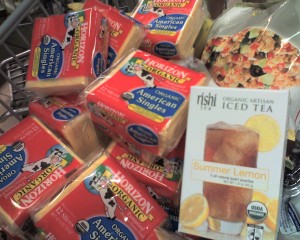
1. One of my favorite “savings posts” – and honestly, not just for “green means” either. Here are the things to AVOID doing – My Top 10 Don’ts. Follow these rules and I swear you’ll save money!
2. Hate spending money on kids’ stickers? So do I! So much packaging waste and they’re a total rip-off! Here’s a post about what you can do instead.
3. Buying in Bulk and Watch Those Labels! You don’t have to trek to a big box store to buy in bulk. You can save by stocking up on discounted items at your regular grocer. Read this post for more info.
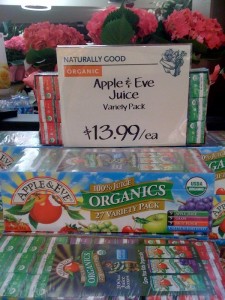 4. Bigger Isn’t Always Better – the “bulk savings bin” or “special deals” aren’t always the cheapest way to go. See this post for details – but check what you need and read labels and per ounce/per serving pricing carefully. If you waste something, you’re not really saving anything – and it’s not very green, is it?
4. Bigger Isn’t Always Better – the “bulk savings bin” or “special deals” aren’t always the cheapest way to go. See this post for details – but check what you need and read labels and per ounce/per serving pricing carefully. If you waste something, you’re not really saving anything – and it’s not very green, is it?
5. CSAs are a great way to save money on organic, local, farm-fresh and even biodynamic foods. Did you know you can save even more money by sampling a CSA? Read this post to learn how.
6. Disappointed by in-store expired coupons? Don’t be – take a few minutes to go to customer service to get the money you’re owed! Here’s my experience at Whole Foods.
7. Not finding what you want? Look up, look down, look all around. Did you know that most stores put the most expensive items at eye-level? That means you have to crane your neck to look up, look down, look all around and find what you want, as this post demonstrates!
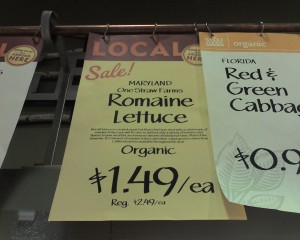
8. Late Night Specials at Whole Foods: Perfect for tomorrow’s lunch or a late night snack, did you know you can grab the day’s freshly made gourmet sandwiches for half-off in the evening? Read more here.
9. Waste-free lunches are green, cheap and easy. Sure, you can buy some of the lovely waste-free lunch kits. But you don’t have to. You can make your own or brown-bag it. Here’s how.
10. Green Household Cleansers: Make Your Own! Vinegar, baking soda, castille soap, and maybe some lemon. That’s really all you need! Read more here, and check out The Smart Mama too. She’s a wealth of knowledge about green cleaning – she has some great “cleaning recipes” on her site to help you!
Hope you enjoyed all these “oldie but goodie” posts on saving through green means! Leave a comment and share your best tips!
Filed under Coupons, My Organic Market, Savings Tips, Where to Buy Organics, Whole Foods | Wordpress Comment (1) |How to Pack A Cheap and Easy Waste-Free Lunch
There are many eco-friendly options available for school lunch, but let’s face it: most of them are still pretty pricey. Shelling out $21 for a Sigg water bottle or $37.95 for a Laptop lunch box adds up to big bucks quickly.
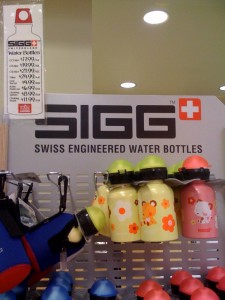
The very popular Sigg bottles range in price from $17.99 to $24.99 at this Bethesda Whole Foods.
Here are five super cheap, easy ways you can send your kids back-to-school with an eco-friendly lunch bag. If you’re fortunate enough to have what you need already, maybe you could take this post and send it to a school list serv or to others who might find this information helpful.
There are really just five things you need for a waste-free lunch:
1. Lunch box – or brown bag. While there are great eco-friendly lunch box options out there, most range from $14 on up. You can buy a pack of 100 brown paper lunch bags for $1.99. No, it’s not totally waste-free, but most municipalities recycle paper – so you can toss the bag out with the newspapers to be recycled! It’s a much more environmentally friendly option than buying a conventional school lunch bag, which are often made of PVC plastic. Read here to learn why you want to avoid PVC, which is harmful to our health and to the environment.
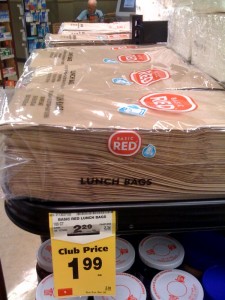
As seen in a Bethesda Safeway, buy 2 packages for $3.98 and you'll have enough recyclable brown bags for the entire school year.
2. Water bottles. This is a biggie. Visit nearly any school cafeteria and you’ll see a staggering amount of waste from disposable juice boxes and milk containers. Yet most stainless or non-PVC water bottles are $10 and up – some as high as $25 or more. Before I invested in two Sigg Mr. Sharky’s (pictured below), I used a good ole Honest Tea bottle. Made of durable glass, it was fine for drinks on the go. I still use one in a pinch!
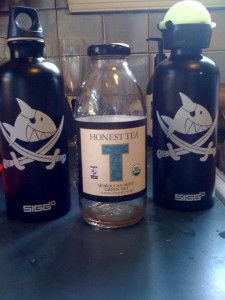
A durable glass bottle, such as this Honest Tea bottle, can be reused as an on-the-go water bottle.
3. Cloth napkin. No need to buy new here. Pretty much everyone has a spare dish rag or dish towel lying around the house, or some “good” cloth napkins that are only taken out for “special occasions.” These are perfect for school lunch. So far, my son hasn’t asked why he carries a linen dishcloth with a 1977 calendar on it, but I’m sure that day is coming soon…!
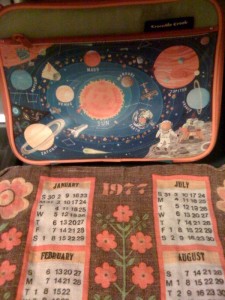
Yes, that's my mother's calendar dish towel from 1977, now doubling as a napkin in my son's lunch box. Do I get a Reduce, Reuse, Recycle, Refuse award for this?
4. Food containers. My how things have changed just in the past year. Now you can buy stainless steel containers for school lunch. But again, cost is an issue. If you don’t want to spend $40 for an all-in-one lunch kit or $16 for a stainless steel food container, you can go the el cheapo route like I did.
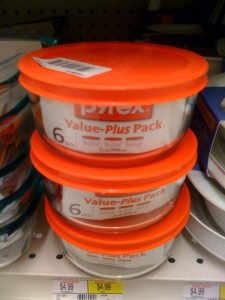
Three of these glass Pyrex food storage units sell for just $4.99 at a Bethesda Giant Food store.
Unfortunately there are no more of these nifty $4.99 glass pyrex containers at the Bethesda Giant, because I bought out their entire stock!
And here’s a shot of Big Boy with his lunch bag, which contains some plastic (gasp) Gerber food containers. I love these. They’re made in the good old USA, they’re cheap (under $5 for 4 small dishes) and they’re made of #5 plastic, which does not contain BPA. Still, to be on the safe side (because all plastics can leach) I keep these plastic bowls out of the dishwasher and the microwave I had to search high and low for these – they seem to sell out as soon as they’re in stock, but you can sometimes find them at Target or Buy Buy Baby.

He’s also carrying a more traditional “Green Mom” accoutrement – a Wrap n’ Mat sandwich wrap, which is made of washable cloth and durable, low density polyethylene (LDPE). These sell for $7.99 on the Internet, but I bought mine locally at My Organic Market. When I hit the Wrap n’ Mat website as I was writing this post, I learned that they’ve just introduced little snack pouches, which sell for $8.99 each.
5. Cutlery. This past school year I packed lunches with our regular cutlery, and unfortunately I regret it because some of our silverware never made it home. This year I’m trying Sporks !
And I leave you with a picture of my boys’ trusty Crocodile Creek lunch bags being cleaned out. Because this frugal green Mom isn’t planning to buy new ones this year!
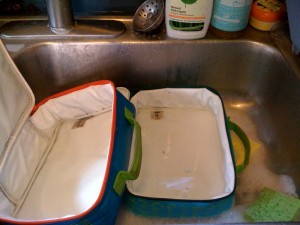
This post is for the Green Moms Carnival: Green Schools Edition, which runs tomorrow (Monday, August 10th) right here at OrganicMania.
— Copyright 2009 OrganicMania
Filed under Bethesda, Food, Giant, Green moms, Green Schools, My Organic Market, Product Recommendations, Savings Tips, School lunches, Sustainable Packaging, Tips, Whole Foods | Wordpress Comments (13) |Great Deals on Recycled Toilet Paper & Why TP Shouldn’t Be at the Bottom of Your Green List
Perhaps you saw the news a few days ago: reports from Greenpeace, publicized in The New York Times, Fast Company, and the UK newspaper The Guardian, which emphasized the importance of choosing recycled toilet paper over “squeezably soft” brands, which get that softness from wood pulp found only in virgin forests.
Going green involves huge changes in buying behaviors: everything from food to clothing to houses, cars, and even toilet paper gets looked at with increased awareness of its ecological impact.
And for many of us — well, swapping out our favorite toilet paper brand is at the bottom of the list. I’ll admit it: I didn’t give much thought to recycled toilet paper, figuring that I’d just wait until the prices came down and the quality came up. Memories of scratchy paper from overseas didn’t do anything to encourage me to check out recycled toilet paper, and frankly, I didn’t realize the extent to which premium toilet paper is taken from old growth forests. (Read more of this disturbing news here).
So I took a fresh look at recycled toilet paper versus conventional, and found big changes in the marketplace. Did you realize you can buy recycled paper for less money than conventional toilet paper?
CVS recently introduced CVS Earth Essentials, recycled content napkins, toilet paper, and paper towels. I decided that at .89 cents a roll, I could spring for one, and put it to the test versus Scott bathroom tissues, available on the same drugstore shelf for $1.29 per roll, and Seventh Generation, available at Whole Foods for $1.39 per roll.
The verdict? Recycled toilet paper has come a long way. Yes, from the perspective of “The Princess and the Pea,” you do notice a bit of a difference, but it is very slight and not nearly enough to merit being called “scratchy.” The quality is equivalent to the type of toilet paper you find in most public buildings. It’s fine.
And it’s really cheap in bulk. After the successful home test, I returned to CVS to stock up. They’re running a sale on four packs of Earth Essentials, now $3.49, on sale from $4.69 through April 30th. That’s a $1.20 savings per 4-pack. But the savings really add up when you buy a 12-pack for $8.99. That’s less than 75 cents per roll. And if you have a CVS “ExtraCare card,” you may reap even more savings. My initial .89 cent purchase yielded a $5 off any $15 purchase, so when I returned to pick up the 12-pack, I added a few other things in my cart and saved even more.
The CVS Earth Essentials toilet paper rated a “Green Tree” stamp of approval from Greenpeace. (Unfortunately the other Earth Essentials products didn’t rank quite as highly as their toilet paper). Check out the Greenpeace guide here. Other good bets for best buys include the Trader Joe’s house brand and Whole Foods 365 brand. And don’t forget, you can often get 10% off a case of goods such as toilet paper at your local market – just ask! My Organic Market offers this discount plus a “best price” guarantee. Other good sources include CSAs, which often stock paper goods too.
So what are you waiting for? Take the switch to recycled toilet paper off the bottom of your list today!
— Lynn
Copyright OrganicMania 2009
Filed under CSAs, CVS, Giant, My Organic Market, Organic Personal Care Products, Organic Prices, Product Recommendations, Savings Tips, Tips, Trader Joes, Where to Buy Organics, Whole Foods | Wordpress Comments (15) |10 Tips to Green Your Labor Day Weekend: Green & Organic Savings Friday
It’s hard to believe that Labor Day is here already. I know so many folks who barely rested this summer. But summer’s nearly over. That’s why it’s so important to take a break – even a small one- this Labor Day weekend.
And with worries about the economy weighing on so many people’s minds, it’s good to know that going green can actually save money. “Green” items such as recycled and biodegradable items have dropped in price due to rising demand.
Here’s a look at what you can expect at the stores this week-end as you stock up, along with 10 tips for greening your Labor Day holiday.
1. Need to mow the lawn to make your yard look beautiful? Forget about conventional gas and electric mowers. Go retro with a good old fashioned push mower. Not only will you help to save the planet, you’ll get real exercise too! If you must use gas or electric, how about sharing a mower with your neighbors?
2. Running out to pick up a grill? Big Green Purse author Diane MacEachern has some great tips on solar-powered and other “green grills” here.
3. Cleaning off the dirty lawn chairs? Remember to use green cleaners. There’s no excuse now, with prices down to $2.98 on Green Works cleaners, available at major stores including national supermarket chains, Target, and Walmart. Or save even more money by using a simple mix of vinegar and water. Want to cut the vinegar odor? Add parsley or lemon to your cleaning solution.
4. Thinking of showing off your patriotism with some red, white and blue party favors? Skip them. Be a true patriot and reduce your consumption of plastics and paper. Spend the money instead on compostable corn-based party plates and cutlery. But be sure to buy from a store like My Organic Market which will compost these items for you, since few municipalities offer composting and backyard systems won’t cut it.
5. Planning the menu? Re-think the beef. Beef is a key contributor to global warming. Can you go veggie? There are great veggie alternatives available like delicious veggie burgers, soy-based corn dogs, and of course the old staples of potato and pasta salad. And if you can’t give up the beef, check out Whole Foods, which has some great looking prepared burgers at just a buck a burger.
6. A hot Labor Day and kids? Whole Foods has Honest Kids Juice Quenchers are on sale for $7 for 2 boxes of 8 pouches, marked down from $4.69 each. And remember, at Whole Foods, even if it says “2 fer” you can actually get that price on just one item. Don’t forget to return the empty Honest Kids juice packs to Terracycle so they can make fabulous bags from them!
7. What’s a party without chips? Now’s a great time to try Snikiddy Snacks Grilled Cheese Puffs or Snikiddy Pizza Pie Puffs. They’re on sale at the Tenleytown DC Whole Foods for 2 bags for $6, down from $4.39 each.
8. Time to clean up? Whip out the biodegradable plastic trash bags, now as cheap as conventional bags at My Organic Market.
9. When dusk comes, and you head inside, open the windows instead of turning on the air conditioner. You’ll save money and the environment!
10. If you’re heading back home to the big city after enjoying time at the beach, you may want to check out the local farmers markets and grocers. We pick up organic fruits when we are in smaller towns that enjoy a lower cost of living than our big city home town.
Have a great holiday weekend!
Lynn
— Copyright 2008 OrganicMania
Filed under Holidays, Savings Tips | Wordpress Comment (1) |10 Tips for Saving Money on Organic Food: Scott Nash of MOM’s
Yesterday’s discussion about the food crisis aside, in our own homes, many of us are struggling to keep putting organic foods on the table when prices are rising with no end in sight. The New York Times recently reported that a gallon of organic milk is hitting $7 in some parts of the U.S. Yikes!
So what can you do? OrganicMania reached out for advice to Scott Nash, Founder and CEO of My Organic Market (MOM’s), an innovative organic grocer in Maryland and Virginia. Here are Scott’s top ten tips for saving money at the organic grocery store.
1. Look for a price guarantee where you shop. Some organic grocers (like MOM’s) will guarantee the lowest price.
2. Buy in bulk. There are organic grocers (like MOM’s) who will offer 10% case discounts on products like 3 lb. wheels of cheese, nuts, grains, granolas, beans, etc.
3. Substitute less expensive veggies in place of expensive ones. Think broccoli, cauliflower, green peppers, and yellow onions instead of asparagus, red peppers, and sweet onions.
4. Buy what’s in season. Organic strawberries, for example, were $6 per lb. a few weeks ago, but now they’re already down to $4 and will keep dropping.
5. For out of season produce, shop the freezer section.
6. Drink water out of the tap – it’s cheaper and better for the environment. (Editor’s Note: Studies have shown that much of the bottled water out there is not any better than what comes out of your tap, and in some cases, its of inferior quality!)
7. Choose more grains and pasta.
8. Plant a garden.
9. Try to cook fresh meals at home instead of buying prepared foods or previously frozen dishes.
10. Cook your meals on 1 or 2 days per week when you have the time and then eat them throughout the week.
Do you have other organic savings tips? Please leave a comment and share!
And stay tuned, because starting next Friday, OrganicMania kicks off a carnival of green and organic savings. We’ll be using “Mr. Linky” to gather all of your tips. Please think about planning a post for next week. You can copy it into Mr. Linky and leave a link back on your site. I’ll have more details as we get closer to launch.
Let’s all help each other out by sharing ideas!
Happy Shopping!
Lynn
Copyright OrganicMania 2008
Filed under Food, Organic Prices, Organics, Savings Tips, Where to Buy Organics | Wordpress Comments (8) |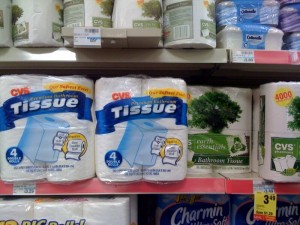
 My StumbleUpon Page
My StumbleUpon Page



